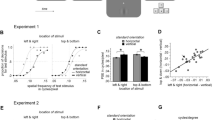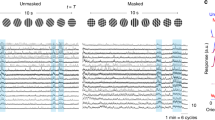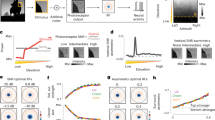Abstract
From the fact that the retina is rather inhomogeneous, it can be inferred that the perception of spatial patterns of appreciable extent will be dependent on the retinal location. Anatomical, electrophysiological and psychophysical findings substantiate the claim that the retina is very inhomogeneous of composition. In order to investigate the influence of this inhomogeneity on the perception of patterns, a model of spatiotemporal signal processing in the retina was developed on the basis of a paradigm for the Weber type adaptation. Such “scaling-ensembles” proved successful in the prediction of spatiotemporal modulation transfer in the human fovea (Koenderink et al., 1971). One prediction of the present model is that certain spatial patterns are optimally detected at well defined retinal locations, dependent on the spatial frequency content of the stimulus. A confrontation of the model's predictions with measurements published by Bryngdahl (1966) enabled us to estimate some of the relevant parameters of the retinal receptive fields as a function of the eccentricity. We obtained estimates that compare reasonably well with previously known values; for instance with values of acuity and anatomical measurements. The present discussion bears relevance on the question of whether the retina is composed of independently tuned spatial frequency filters at any retinal location, or whether the tuning is with respect to the eccentricity.
Similar content being viewed by others
References
Alpern, M.: Introduction to movements of the eyes. In: The eye, ed. H. Davson, vol. III, chap. 1, 4. New York: Academic Press 1962.
Aubert, H.: Physiologie der Netzhaut. Breslau: Morgenstern 1865.
Békésy, G. von: Neural inhibitory units of the eye and skin. Quantitative description of contrast phenomena. J. opt. Soc. Amer. 50, 1060 (1960).
Boycott, B. B., Bowling, J. E.: Organization of the primate retina: light microscopy. Phil. Trans. B255, 109–176 (1969).
Bryngdahl, O.: Perceived contrast variation with eccentricity of spatial sine-wave stimuli. Vision Res. 6, 553–565 (1966).
Campbell, F. W., Robson, J. G.: Application of Fourier analysis to the visibility of gratings. J. Physiol. (Lond.) 197, 551–566 (1968).
Daitch, J. M., Green, D. G.: Contrast sensitivity of the human peripheral retina. Vision Res. 9, 949–952 (1969).
Daniel, P. M., Whitteridge, D.: J. Physiol. (Lond.) 159, 203–221 (1961).
Dor, H.: Beiträge zur Electrotherapie der Augenkrankheiten. Albrecht v. Graefes Arch. Ophthal. 19, 316 (1873).
Druault, A.: Astigmatisme des rayons pénétrant obliquement dans l'oeil. Application de la skiascopie (1). Albrecht v. Graefes Arch. Ophthal. 20, 21 (1900).
Fischer, B., May, H. U.: Invarianzen in der Katzenretina: Gesetzmäßige Beziehungen zwischen Empfindlichkeit, Größe und Lage receptiver Felder von Ganglienzellen. Exp. Brain Res. 11, 448–464 (1970).
Helmholtz, H. von: Handbuch der physiologischen Optik, vol. 2. Hamburg: Voss 1911.
Hylkema, B. S.: Examination of the visual field by determining the fusion frequency. Acta ophthal. (Kbh.) 20, 181–193 (1942).
Jacobs, G. H., Yolton, R. L.: Center-surround balance in receptive fields of cells in the lateral geniculate nucleus. Vision Res. 10, 1127–1144 (1970).
Jung, R.: Neuronal mechanisms of pattern vision and motion detection. In: Sensory processes at the neuronal and behavioral levels, ed. G. V. Gersuni. New York: Academic Press 1971.
Jung, R., Spillmann, L.: Receptive field estimation and perceptual integration in human vision. In: Early experience and visual information processing in perceptual and reading disorders. Washington D. C.: Nat. Acad. Sciences 1970.
Kelly, D. H.: J0 stimulus patterns for visual research. J. opt. Soc. Amer. 50, 1115 (1960).
Koenderink, J. J., Grind, W. A. van de, Bouman, M. A.: Models of retinal signal processing at high luminances. Kybernetik 6, 227–237 (1970).
Koenderink, J. J., Grind, W. A. van de, Bouman, M. A.: Foveal information processing at photopic luminances. Kybernetik 8, 128–144 (1971).
Le Grand, Y.: Form and space vision, chap. 8. Bloomington: Indiana University Press 1967.
Lipetz, L. E.: Glial control of neuronal activity. Trans. IEEE, MIL-7, 144 (1963).
Nes, F. L. van: Experimental studies in spatiotemporal contrast transfer by the human eye. Utrecht: Thesis R. U. 1968.
Nes, F. L. van, Koenderink, J. J., Nas, H., Bouman, M. A.: Spatiotemporal modulation transfer in the human eye. J. opt. Soc. Amer. 57, 1082 (1967).
Østerberg, G.: Topography of the layer of rods and cones in the human retina. Acta ophthal. (Kbh.), Suppl. 6, 1–102 (1935).
Polyak, S.: The retina. Chicago: Chicago University Press 1941.
Rolls, E. T., Cowey, A.: Topography of the retina and striate cortex and its relationship to visual acuity in Rhesus monkeys and Squirrel monkeys. Exp. Brain Res. 10, 298–310 (1970).
Schade, O. H., Sr.: Optical and photoelectric analog of the eye. J. opt. Soc. Amer. 46, 721 (1956).
Sperling, G.: Models of visual adaptation and contrast detection. Perception and Psychophysics 8, 143 (1970).
Svaetichin, G., Negishi, H., Drujan, B., Muriel, C.: S-potential and retinal automatic control systems. In: Proc. First Eur. Biophysics Congr. vol. V, eds. E. Broda, A. Locker, H. Springer-Lederer. Vienna 1971.
Troxler, D.: Über das Verschwinden gegebener Gegenstände innerhalb unseres Gesichtskreises. Ophthalmol. Bibliothek, eds. Himly and Schmidt, Jena 2, 51–53 (1804).
Vilter, V.: Recherche biométrique sur l'organisation synaptique de la rétine humaine. C.R. Soc. Biol. (Paris) 143, 830 (1949).
Wertheim, T.: Über die indirekte Sehschärfe. Z. Psychol. 7, 172–187 (1894).
Author information
Authors and Affiliations
Rights and permissions
About this article
Cite this article
van Doorn, A.J., Koenderink, J.J. & Bouman, M.A. The influence of the retinal inhomogeneity on the perception of spatial patterns. Kybernetik 10, 223–230 (1972). https://doi.org/10.1007/BF00288741
Received:
Issue Date:
DOI: https://doi.org/10.1007/BF00288741




